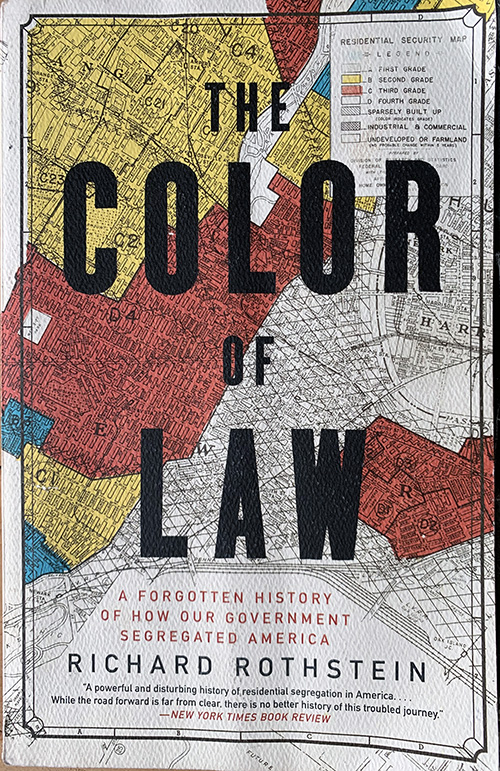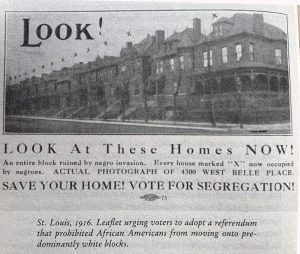Richard Rothstein
Liveright

I must start by objecting to the book’s subtitle: A Forgotten History of How Our Government Segregated America. Many African Americans have not forgotten this history because it is lived daily. Segregation, directed and sanctioned by the US government, persists to this day. Therefore, an assumption can be made that this book is for the doubters and all others who still have the ability to make a difference with an acknowledgment and rectification of this disturbing history. As Rothstein states, “This is not a book about whites as actors and blacks as victims” (xv), but citizens in a democracy who all must take action to enforce our constitution. In this case, Rothstein has put forth a detailed and powerful history of residential segregation in America. He describes how the government at all levels divided America, revealing devices that may further enlighten even those who are aware of this history and its consequences.

The Color of Law begins by revealing public policy that intentionally segregated every city and metropolitan area in America. Rothstein organizes a solid argument that the government not only purposely enacted policy and laws guaranteeing segregation (which would have still existed through private forces) but also enabled segregation to flourish and become the main organizing factor in the metropolitan landscape. Making the case that the greatest form of American housing segregation was not de facto segregation but de jure segregation, this work gives a concise yet inclusive legal, political, and social history of how this occurred. Rothstein reveals this history by going back to the thirteenth amendment, which not only abolished slavery but also banned actions that made African Americans second class citizens, such as racial discrimination in housing. The pattern of housing discrimination began when the government disagreed with and disregarded its own laws and their intents. In 1883, the Supreme Court agreed with the second section of the thirteenth amendment, which prohibited the actions that perpetrated the conditions of slavery, but it argued that housing discrimination did not apply. From this point on in his book, Rothstein traces how the protections of civil rights were effectively ignored, disregarded, twisted, and trampled. This is where The Color of Law stands apart; there have been other books on this subject—including Antero Pietila’s Not in My Neighborhood, about redlining in Baltimore—but none do so with such comprehensive proof and portraiture of devious and brazen intentionality. For as Rothstein states, “Congress was correct when it determined that prohibiting African Americans from buying or renting decent housing perpetuated second-class citizenship that was a relic of slavery” (ix).
Within the pages, chapter after chapter, the efforts to exclude African Americans unfold from the most contradictory places. For example, Southern senators and congressmen supported the economic reforms of Franklin Delano Roosevelt’s New Deal, but only if it excluded industries in which African Americans predominated, such as agriculture. Public housing was initiated with rapid population growth during World War II, but it was officially segregated. White war worker housing was built close to white residential areas, and black war worker housing was located along the railroads and close to industrial areas. Rothstein describes how the Federal Housing Authority (FHA)—created in 1934 to insure mortgages that allowed middle class renters to buy houses—discouraged banks from offering any loans in urban neighborhoods preferring newly built suburbs. There were specific cases where banks were willing to issue mortgages if the FHA would have approved them, yet according to The Color of Law, the agency stated that ’no loans will be given to coloured developments’ (66). Rothstein also details how the US Departmet of Veterans Affairs (VA), which guaranteed mortgages to returning servicemen, had similar policies, even relying on the FHA Underwriting Manual. In many cases, the VA would not insure an individual mortgage if the subdivision was not all white residents. Thus, these federal agencies fully supported developments that had restrictive racial covenants sponsoring private entities that banned and discriminated against African Americans. Rothstein’s book presents the brazen discriminatory language used in most of these covenants. One such document reads as follows: “The real property above described, or any portion thereof, shall never be occupied, used or resided on by any person not of the white or Caucasian race, except in the capacity of a servant or domestic employed theron [sic] as such by a white Caucasian owner” (78-79). The last part of this statement indicates that the desire was not for African Americans to disappear but to remain in their would-be predetermined station in life. Ultimately, The Color of Law exposes myriad racially exclusive tactics, policies, and programs that federal, state, and local governments sanctioned: from exclusionary zoning to redlining/devaluing integrated neighborhoods, Section 8 public housing voucher programs, and the policy in which the Internal Revenue Service granted tax-exempt status to churches, hospitals, universities, neighborhood associations, and other groups that promoted residential segregation, which reinforced the desire to keep African Americans from full participation in American democracy. Whites wanted superiority at all costs.

The last part of The Color of Law attempts to offer fixes. The recommendations mostly center on methods to integrate African Americans into white or segregated neighborhoods. This, however, in many opinions, is not as effective as dealing with socioeconomic equity in the neighborhoods in which African Americans currently reside, neighborhoods that are currently losing to redevelopment and gentrification. I wholeheartedly agree with Rothstein when he states, “As a nation, we have paid an enormous price for avoiding an obligation to remedy the unconstitutional segregation we have allowed to fester. African Americans, of course, suffer from our evasion. But so, too, does the nation as a whole, as do whites in particular” (195). Contrary to this cry for taking responsibility and remedying this injustice, there are still voices saying that affirmative actions or proactive remedies are not necessary or are even harmful. Unjust: Social Justice and the Unmaking of America, a recent book by Noah Rothman, makes this case. Proposals to rectify past injustices with new actionoften come about without acknowledging the systemic historical context and the importance of accurately educating young people so that they can have a chance at a just and equitable democracy. In The Color of Law, Rothstein does recognize and give credence to the historical context of this injustice, acknowledging “that remedies to undo nearly a century of law sanctioned residential segregation will have to be complex and imprecise”(143). Rothstein’s main thesis here is that segregation was not created by accident or by undefined private prejudices, and it cannot be changed by accident or by changing people’s hearts. It can be changed through active citizenship, progressive policies and actions by the federal, state, and local governments that segregated the United States.

Diane Jones Allen is the Program Director for Landscape Architecture in the College of Architecture Planning, and Public Affairs, University of Texas at Arlington, and Principal Landscape Architect of DesignJones LLC in New Orleans, LA. In 2017, she participated as a member of the ASLA Blue Ribbon Panel on Climate Change and Resiliency. She also serves on the Board of the Landscape Architecture Foundation (LAF), contributing to the diversity and climate change sub-committees. She received the 2017 Distinguished Alumni Award from the College of Environmental Design, University of California at Berkeley. Her research and practice is guided by the intersection of environmental justice, identity and sustainability in cultural landscapes, including “Nomadic” responses to “Transit Deserts,” places of increasing transportation demand and limited access, as discuss in her book Lost in the Transit Desert: Race, Transit Access, and Suburban Form (Routledge, 2017). She recently co-edited Design for Democracy: Techniques for Collective Creativity (Island Press, 2017) which provides tools for trans-active engagement and design.
How to Cite this Article: Jones Allen, Diane. Review of The Color of Law: A Forgotten History of How Our Government Segregated America, by Richard Rothstein. JAE Online. October 25, 2019. http://www.jaeonline.org/articles/review/color-law#/.






